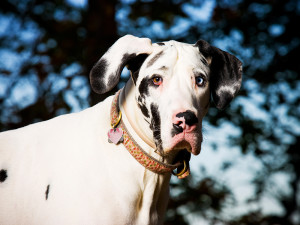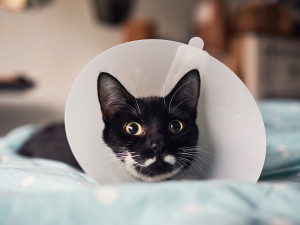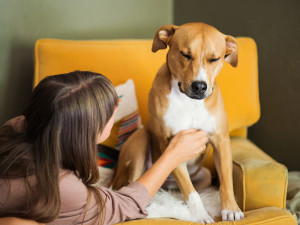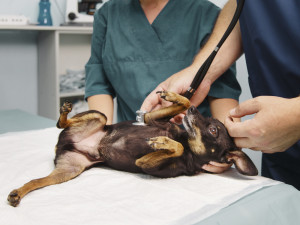Beware of Bloat in Dogs
Consider it the mother of all dog emergencies — if your dog has it, take them to the vet ASAP. Learn how to spot the condition and how it's treated.
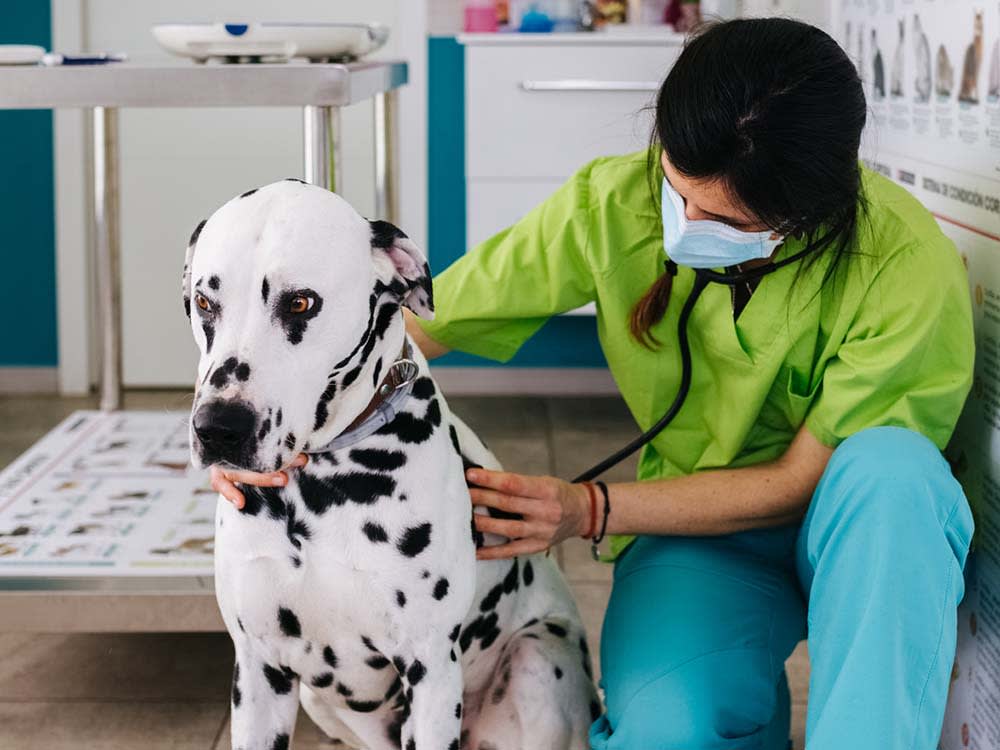
share article

Your pet wants you to read our newsletter. (Then give them a treat.)
There's no quicker way to jump to the front of the veterinary ER line than walking into the hospital with a dog who has bloat — a condition in which a dog's stomach fills with air, gas, or fluid, which causes the stomach to expand and distend. In some cases, this can progress to a twisting of the dog's stomach, called gastric dilatation volvulus (GDV).
Bloat is a life-threatening condition that I treat frequently, and a good outcome is time-dependent. That means, if you even remotely suspect your dog has bloat or GDV, take them to a veterinary hospital ASAP. Keep reading to learn the signs of bloat to lookout for, plus how the condition is treated.
What is GDV in dogs?
Gastric dilatation volvulus (GDV) is the twisting and bloating of the dog's stomach. Think of a balloon being twisted in half, like when a clown makes an animal figure. The enlarged stomach presses on the major blood vessels that carry blood back to the heart, stopping normal circulation and sending the dog into shock. Making matters worse, the dog's stomach tissue is literally dying because it is stretched tightly and blood cannot circulate through it. Intense pain is associated with this disease, causing the heart to race at such a high rate that heart failure will result.
Symptoms of GDV or bloat in dogs
The biggest sign of bloat is vomitingopens in a new tab. A dog with bloat appears highly nauseated and retches but little comes up. It's important to recognize the signs of bloat — for each hour that goes by, there is a greater risk for complications. Here are the signs to look out for:
Anxiousness
Agitation
Restlessness
Pacing
Drooling
Depressed attitude
Swollen or distended stomachopens in a new tab
Hard or tense stomach
Vomiting, highly nauseated but little comes up
What causes bloat in dogs?
There are many theories regarding what triggers bloat in dogs, but truly, no one really knows — it remains a veterinary medical mystery. Risk factors, lifestyle, and personality profiles that may increase a dog’s potential for developing bloat have been identified over the years. These may include:
Having closely related family members with a history of GDV
Feeding only one meal a day
Feeding from an elevated bowl
Restricting water before and after meals
Being thin or underweight
Moistening dry foods (particularly if citric acid is listed as a preservative in the dry food).
Feeding a dry diet with animal fat listed in the first four ingredients. (Contrary to popular belief, cereal ingredients such as soy, wheat, or corn in the first four ingredients do not increase the risk.)
Fearful or anxious temperament
History of aggression toward people or other dogs
Male dogs are more likely to bloat than females
Older dogs (seven to 12 years) are the highest risk group
Large dogs with deep chests are at a much higher risk
Bloat affects deep-chested breeds, and dogs with deep chests that weigh more than 99 pounds have a 20 percent risk of bloat. Although a rare occurrence, I have also treated three small-breed dogs for this condition in my ten-year career.
Can bloat in dogs be prevented?
You can likely reduce the risk that your dog experiences bloat by:
Feeding multiple small meals spread throughout the day
Avoiding stressful events like travel and boarding
Avoiding overfeeding
Maintaining an appropriate body weight (being underweight is a risk factor
Reducing aggression and fearful behavior through training
For breeds with a high risk of bloat, a preventive surgery called prophylactic gastropexy can be performed at the time of spay or neuter. Gastropexyopens in a new tab involves surgically “tacking down” the stomach to the inside of the abdomen to prevent rotation. If your dog has already been spayed or neuteredopens in a new tab, the same procedure can be done laparoscopically and is minimally invasive. I had this procedure performed on my own Dobie, Bauer. I saw him bloat (and thankfully not twist!) one day at the park and treated him at work.
The next day, I scheduled the laparoscopic procedure. This is a same-day surgery with a quick and comfortable recovery. In the Bay Area, the cost is generally $1,500–$2,000, which is far cheaper than emergency surgery, and worth its weight in gold for peace of mind. It's important to note that gastropexy does not prevent future bloat in dogs, but it does prevent future twisting, which is the deadly component of the condition.
How is bloat in dogs treated?
Treatment depends on the severity of the dog's condition. Taking an x-ray of your dog's abdomen is the only way to tell the difference between bloat and GDV, allowing for appropriate intervention.
A dog with bloat can die in a matter of hours unless emergency gastropexy surgery is performed. There can be no recovery until the stomach is surgically untwisted and the gas is released. For each hour that goes by, there is a greater risk for complications during surgery as well as during the recovery period.
Decades ago, a diagnosis of bloat was almost always a death sentence, and only 25 percent of pets with bloat survived. Today, the survival rate of bloat is better than 80 percentopens in a new tab! Part of the reason for this is increased human awareness, leading to rapid intervention and treatment. The earlier the veterinarian starts treatment, the better the dog's chance for survival. Extremely aggressive medical and surgical intervention early in the course of the disease has the most dramatic impact on overall success. From personal experience, nearly all dogs return home (95 percent or greater) with early and appropriate veterinary medical treatment.
What to do if your dog has bloat
Seek veterinary care ASAP. Do not attempt to treat your dog at home by giving them medications like Gas X — it may help reduce the amount of stomach gas in the case of “simple” bloat, but it will do nothing to help your dog in the case of GDV.
Remember: The problem with GDV is not the gas bloating, but the actual twisting of the stomach. It is the twist that kills, and a medication will not undo the deadly rotation of the stomach. Please do not waste valuable life-saving moments waiting to see if medication helps — and do everything you can to help raise awareness of this all-too-common condition.
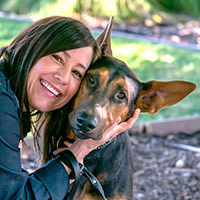
Dr. Shea Cox, DVM, CVPP, CHPV
Dr. Shea Cox is the founder of BluePearl Pet Hospice and is a global leader in animal hospice and palliative care. With a focus on technology, innovation and education, her efforts are changing the end-of-life landscape in veterinary medicine.
Related articles
![White and black spotted Great Dane with two different colored eyes looks into the camera]() opens in a new tab
opens in a new tabHere’s How You Can Prevent Dangerous Bloat in Your Dog
Bloat is one of the leading causes of death in deep-chested dogs. This elective surgery can lower the risk.
![Black cat with white spots on its fur laying on a light blue blanket while wearing a con around its head]() opens in a new tab
opens in a new tabBe Prepared: Four Pet Emergency Room Essentials for Pet Parents
Lay the groundwork for quick, low-stress treatment.
![A pet parent checks their dog's stomach.]() opens in a new tab
opens in a new tabDIY Physical Exam Part 4 — How to Examine Your Dog’s Stomach and Skeleton
Veterinarian Dr. Shea Cox on how to properly examine your dog’s stomach and musculoskeletal system.
![A dog getting checked out at the vet]() opens in a new tab
opens in a new tabWhat to Expect At the Emergency Vet
It's every pet parent's nightmare — but knowing what happens when you take your dog to the ER can make the experience a little less stressful.

